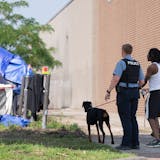Opinion editor’s note: Strib Voices publishes a mix of national and local commentaries online and in print each day. To contribute, click here.
•••
There now is no question that Chicago needs the gunfire detection technology known as ShotSpotter.
We sympathize with those who wish this financially strapped city did not have use for an expensive system designed to get police officers more quickly to a bloody scene on its streets. We dearly wish the same. But the data is clear. Need it we do. To remove it will cost the lives of Chicagoans.
Back in May, we noted that whatever arguments had been made against ShotSpotter as a tool to catch and arrest violent criminals were ignoring something yet more important: the technology’s ability to get help quickly for shooting victims, including those rapidly bleeding to death. In an ideal city, people would call 911 and emergency workers would rush immediately to the scene; heck, in an ideal city, those scenes would never materialize in the first place. But we do not inhabit such a halcyon place. In the here and now, those scenes play out every weekend.
Recently, the Chicago Tribune published an op-ed piece by researchers from the University of Chicago’s Crime Lab using new data from their work in the field. The conclusion? ShotSpotter saves lives.
The Crime Lab methodology looked at the differences between what happened at shooting scenes right at the boundaries of adjoining police districts — those that have ShotSpotter and those that do not. The idea was to capture as much of a like environment as possible. Districts have to be divided somewhere, and if you look right at where they meet, then other demographic and socioeconomic factors are far less likely to come into play; researchers in other fields, such as education, use the same technique.
What did the University of Chicago researchers find? “After ShotSpotter goes live, fatality rates are about 4 percentage points lower in the areas with the technology. With an overall fatality rate of 17%, this is about a one-quarter drop in the odds the victim dies.”

